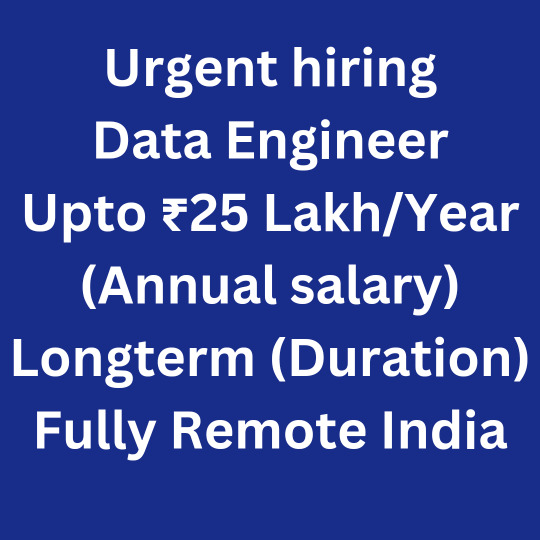#hire data engineers
Text
Supercharge Your Data Strategy: The Benefits of Outsourcing Data Engineers
Learn how outsourcing data engineers can help businesses unlock the true potential of their data for informed decision-making.
#hire data engineers#machine learning consulting#offshore developers#hire software development team#data science experts#ai ml consulting#ai and ml consulting
0 notes
Text
Unlocking Business Potential with Data Science Expertise

In today's data-driven world, businesses are constantly seeking innovative ways to leverage their data for strategic decision-making and competitive advantage. This has led to a surge in demand for skilled data scientists who possess the expertise to extract actionable insights from complex datasets. If you're looking to propel your business forward and unlock its full potential, hiring data scientists could be the key to success.
Why Data Science Matters
Data science is an interdisciplinary field that combines domain knowledge, statistical analysis, and machine learning techniques to uncover patterns, trends, and correlations within data. By harnessing the power of data science, businesses can gain valuable insights into customer behavior, market trends, and operational efficiencies. Whether you're a startup looking to gain a foothold in the market or an established enterprise aiming to stay ahead of the competition, investing in data science can yield significant returns on investment.
The Role of Data Scientists
Data scientists play a crucial role in transforming raw data into actionable insights. They are skilled in collecting, cleaning, and analyzing data from various sources to uncover hidden patterns and trends. Additionally, data scientists have expertise in machine learning algorithms and predictive modeling techniques, allowing them to build sophisticated models that drive business decisions. By hiring data scientists, businesses can enhance their decision-making processes, optimize operations, and drive innovation across the organization.
Benefits of Hiring Data Scientists
Hiring data scientists offers numerous benefits for businesses of all sizes:
1. Data-Driven Decision Making: Data scientists empower businesses to make informed decisions based on empirical evidence rather than intuition or guesswork.
2. Competitive Advantage: By leveraging advanced analytics and predictive modeling, businesses can gain a competitive edge in their respective industries.
3. Innovation: Data scientists drive innovation by uncovering new opportunities, identifying emerging trends, and developing cutting-edge solutions.
4. Cost Savings: Through optimization and efficiency improvements, data science initiatives can lead to cost savings and revenue generation opportunities.
5. Enhanced Customer Insights: By analyzing customer data, businesses can gain valuable insights into customer preferences, behavior, and sentiment, enabling personalized marketing strategies and improved customer experiences.
Conclusion
In conclusion, hiring data scientists can be a game-changer for businesses seeking to harness the power of data and drive strategic growth. Whether you're looking to optimize operations, enhance customer experiences, or unlock new revenue streams, investing in data science talent is a wise decision. If you're ready to take your business to the next level, consider hiring data scientists and embark on a journey of data-driven success.
#it staff augmentation#hire data engineers#hire data scientist#hire data analyst#hire on demand developers#contract developers#contract it staffing
0 notes
Text
The Significance of Big Data in Healthcare
Big Data in Healthcare has become a trending topic, but understanding its importance in the industry is crucial. In healthcare, every patient's medical history, treatment, and diagnosis are linked to data points that help determine the next course of action. This vast collection of information, often referred to as "big data," is central to advancing healthcare technologies.
What is Big Data Analytics in Healthcare?
Big data in healthcare involves analyzing large sets of both structured and unstructured data to identify key insights and trends. This data includes graphs, videos, texts, images, and more. The primary goal is to improve patient outcomes, support decision-making, and reduce healthcare costs. Sources of big data include electronic health records, personal health records, and electronic medical reports.
The Growth of Big Data in Healthcare
The global market for big data engineering in healthcare is growing rapidly. By 2035, the market size is expected to increase from USD 67 billion to USD 540 billion, with a projected growth rate of 19.06%. This expansion highlights the increasing reliance on big data for healthcare advancements.
Real-World Applications of Big Data in Healthcare
Electronic health records (EHRs) are one of the most common sources of big data. They contain critical patient information, such as demographic details, immunizations, medical history, test results, medications, and treatment progress. By combining this data with predictive analysis tools like machine learning, healthcare professionals can forecast outcomes such as post-surgical complications and improve the patient experience.
The Role of Predictive Analytics
Predictive analytics in healthcare involves collecting, integrating, and analyzing patient data to make informed decisions. This process includes data collection from EHRs, online surveys, and more. Once collected, the data is cleaned, explored, and used to build predictive models. These models help healthcare organizations make data-driven decisions, ultimately enhancing operational efficiency.
Conclusion
Big data in healthcare is transforming the industry by providing valuable insights and enabling more efficient, personalized care. As the digital era continues to evolve, embracing technologies like machine learning and AI will be essential for further advancing healthcare outcomes.
#big data#big data engineering#big data engineer#hire big data#big data and healthcare#healthcare and big data#big data and healthcare sector#healthcare and big data engineer
0 notes
Text
What Is a Computer Vision Engineer? Unlocking the Power of Sight in Machines

In today's rapidly evolving technological landscape, one of the most remarkable areas of development is computer vision. As humans, our ability to perceive and understand the visual world around us is a fundamental aspect of our daily lives. Similarly, the field of computer vision aims to enable machines to interpret and understand visual data. At the heart of this fascinating domain lies the computer vision engineer, an expert who plays a crucial role in unlocking the power of sight in machines.
In this article, we will delve into the world of computer vision engineering, exploring the responsibilities, skills, and potential applications of this field.
Understanding Computer Vision Engineering:
Computer vision engineering encompasses the design, development, and deployment of systems that enable machines to gain an understanding of visual data. The primary goal of computer vision engineers is to create algorithms and models that can accurately interpret images and videos, replicating human visual perception to some extent. By using artificial intelligence (AI) techniques such as machine learning and deep learning, computer vision engineers equip machines with the ability to analyze, recognize, and make decisions based on visual information.
Responsibilities of a Computer Vision Engineer:
The responsibilities of a computer vision engineer are diverse and demanding. They involve working with large datasets, developing and fine-tuning complex algorithms, and collaborating with cross-functional teams to implement computer vision solutions.
Some key responsibilities include:
1. Data Collection and Preprocessing: Computer vision engineers gather large volumes of visual data and preprocess it to enhance the accuracy of subsequent analysis. This often involves tasks such as data labeling, augmentation, and cleaning.
2. Algorithm Development: Computer vision engineers develop and optimize algorithms that can detect and recognize objects, people, gestures, and other visual cues. They leverage machine learning techniques, such as convolutional neural networks (CNNs), to train models on labeled data and improve their ability to make accurate predictions.
3. Model Evaluation and Optimization: Computer vision engineers evaluate the performance of trained models, fine-tuning them to achieve higher accuracy and robustness. They employ techniques like transfer learning and regularization to enhance the models' generalization capabilities.
4. Integration and Deployment: Once the computer vision systems are developed, engineers work on integrating them into real-world applications. This involves optimizing the models for efficiency, scalability, and compatibility with hardware and software frameworks.
Skills Required:
Becoming a proficient computer vision engineer requires a combination of technical skills and domain knowledge. Some essential skills include:
1. Programming: Proficiency in programming languages such as Python, C++, or MATLAB is crucial for implementing computer vision algorithms and working with relevant libraries and frameworks like OpenCV, TensorFlow, or PyTorch.
2. Mathematics and Statistics: A solid foundation in linear algebra, calculus, probability, and statistics is necessary to understand the mathematical underpinnings of computer vision algorithms and models.
3. Machine Learning: Familiarity with machine learning concepts and techniques is vital for training and fine-tuning models. Understanding topics like supervised and unsupervised learning, neural networks, and optimization algorithms is essential.
4. Image Processing: Knowledge of image processing techniques, such as filtering, segmentation, and feature extraction, allows computer vision engineers to manipulate and enhance visual data before feeding it into models.
5. Problem-Solving and Critical Thinking: Strong problem-solving and critical thinking skills enable computer vision engineers to tackle complex challenges and devise innovative solutions.
Applications of Computer Vision:
Computer vision has many uses in numerous industries. Some famous examples are:
1. Autonomous Vehicles: Computer vision enables self-driving cars to perceive and understand their surroundings, identifying objects, pedestrians, traffic signs, and lane markings to make informed decisions.
2. Healthcare: Computer vision aids in medical imaging analysis, assisting with tasks like tumor detection, disease diagnosis, and surgical planning. It also facilitates remote patient monitoring and analysis of vital signs.
3. Retail and E-commerce: Computer vision is used for product recognition and visual search, allowing customers to find similar products based on images. It also enables automated inventory management and checkout processes.
4. Security and Surveillance: Computer vision systems enhance security by detecting and tracking suspicious activities, recognizing faces, and analyzing video footage for real-time threat detection.
5. Augmented Reality (AR) and Virtual Reality (VR): Computer vision is instrumental in AR and VR applications, overlaying digital information in the real world or creating immersive virtual environments.
Conclusion:
Computer vision engineering is an exciting and rapidly evolving field that empowers machines with the ability to perceive and understand the visual world. By leveraging AI and machine learning techniques, computer vision engineers unlock the potential for machines to analyze, interpret, and make decisions based on visual data. With applications spanning industries like automotive, healthcare, retail, security, and entertainment, the impact of computer vision is revolutionizing our lives. As technology continues to advance, computer vision engineers will play an increasingly vital role in shaping the future of intelligent machines.
#Hire Machine Learning Developer#Machine Learning Development in India#Looking For Machine Learning Developer#Looking For Machine Learning Dev Team#Data Analytics Company#Vision AI Solution#Vision AI Development#Vision AI Software#Vision API#Vertex AI Vision#computer vision engineers#Computer Vision
0 notes
Text
Hire Data Visualization Engineers to make sense of data
Your company leadership wants to visualize data in clear formats, which is easily to understand, and this is delivered by Data Visualization Engineers. Learn about hiring top Data Visualization Engineers.
#Hire Data Visualization Engineers#Data Visualization#Data Visualization Developers#hiring top Data Engineers
0 notes
Text

Greetings From Ashra Technologies
We are Hiring
#hiring#hiringalert#linkedinconnections#linkedin#linkedinengagement#flex#data#engineer#location#linkdinpost#linkedinfamily#connect#insta#instagram#immediatehiring#immediatejoiner#punejobs#chennaihiring#hiringrecruiters#hiringnow#experiencedjobs
0 notes
Text

#jobs hiring#tech jobs#usa jobs#data engineers#data scientist#indiajobs#full time jobs#remote jobs#remote work
0 notes
Text
According to a report by Domo, we will be producing 165 zettabytes of data per year by 2025. As a result, more and more companies are investing in big data and AI technologies to manage unstructured data. It helps companies to make well-informed decisions and improve metrics such as customer satisfaction, customer retention, organizational efficiency, revenue, etc.
#hire Big Data engineers#big data analytics#hire Big Data engineers in India#remote Big Data engineer jobs#hire data engineer#Big Data engineers
0 notes
Link
How to Overcome Common Challenges in Data Engineering to Make Data Work for You With Minimum Effort
Information is the cornerstone of every business. The way you use the information you have may vary depending on the current needs of your organization. For some, a web app allowing users to check the dates of appointments to the veterinarian will do the trick. Some more demanding business owners may need to use Machine Learning and Artificial Intelligence algorithms to predict customer behavior and adopt their strategy accordingly.
Even if you work in a small company, at some point, you may find that a bunch of excel tables can’t cover your needs anymore. Using different apps that work with different data formats makes everything even more complicated. Without a significant development background, it may be hard even to determine how many databases you need to remain efficient. In such a case, you can rely on data engineers. Their job is to take care of your data infrastructure and the challenges they face along the way will be considered today.
#database#data engineers#web development#web developing company#full stack web development#hire php web developer#web developers#custom software solutions#custom software application#custom software development#custom software#software development#softwaredevelopment#sofwtare#application development#development#app developers#reactjs developers#topdeveloper#hire developers#developers#hire dedicated developers#hire dedicated frontend developers#outsourcing#it staffing company#it staff offshoring#it staff augmentation#staff augmentation#it services
0 notes
Text
Tech Active Guide: Nurturing Connectivity with Remote Team Building
Explore virtual team building and remote work, uncovering benefits, challenges, and strategic initiatives for fostering collaboration. Visit us to know more.
#custom software development companies#custom software development services#hire net developers#machine learning development company#angular js development services#hire front end developer#hire backend developer#dedicated software development team#hire data engineers#machine learning consulting#offshore developers#hire software development team#data science experts#ai ml consulting#ai and ml consulting#custom machine learning solutions#machine learning solutions company#hire top software developers#hire devops engineer#python software engineer#remote python developers#remote full stack developers#remote developers#devops outsourcing
0 notes
Text

LaRue Burbank, mathematician and computer, is just one of the many women who were instrumental to NASA missions.
4 Little Known Women Who Made Huge Contributions to NASA
Women have always played a significant role at NASA and its predecessor NACA, although for much of the agency’s history, they received neither the praise nor recognition that their contributions deserved. To celebrate Women’s History Month – and properly highlight some of the little-known women-led accomplishments of NASA’s early history – our archivists gathered the stories of four women whose work was critical to NASA’s success and paved the way for future generations.
LaRue Burbank: One of the Women Who Helped Land a Man on the Moon
LaRue Burbank was a trailblazing mathematician at NASA. Hired in 1954 at Langley Memorial Aeronautical Laboratory (now NASA’s Langley Research Center), she, like many other young women at NACA, the predecessor to NASA, had a bachelor's degree in mathematics. But unlike most, she also had a physics degree. For the next four years, she worked as a "human computer," conducting complex data analyses for engineers using calculators, slide rules, and other instruments. After NASA's founding, she continued this vital work for Project Mercury.
In 1962, she transferred to the newly established Manned Spacecraft Center (now NASA’s Johnson Space Center) in Houston, becoming one of the few female professionals and managers there. Her expertise in electronics engineering led her to develop critical display systems used by flight controllers in Mission Control to monitor spacecraft during missions. Her work on the Apollo missions was vital to achieving President Kennedy's goal of landing a man on the Moon.
Eilene Galloway: How NASA became… NASA

Eilene Galloway wasn't a NASA employee, but she played a huge role in its very creation. In 1957, after the Soviet Union launched Sputnik, Senator Richard Russell Jr. called on Galloway, an expert on the Atomic Energy Act, to write a report on the U.S. response to the space race. Initially, legislators aimed to essentially re-write the Atomic Energy Act to handle the U.S. space goals. However, Galloway argued that the existing military framework wouldn't suffice – a new agency was needed to oversee both military and civilian aspects of space exploration. This included not just defense, but also meteorology, communications, and international cooperation.
Her work on the National Aeronautics and Space Act ensured NASA had the power to accomplish all these goals, without limitations from the Department of Defense or restrictions on international agreements. Galloway is even to thank for the name "National Aeronautics and Space Administration", as initially NASA was to be called “National Aeronautics and Space Agency” which was deemed to not carry enough weight and status for the wide-ranging role that NASA was to fill.
Barbara Scott: The “Star Trek Nerd” Who Led Our Understanding of the Stars

A self-described "Star Trek nerd," Barbara Scott's passion for space wasn't steered toward engineering by her guidance counselor. But that didn't stop her! Fueled by her love of math and computer science, she landed at Goddard Spaceflight Center in 1977. One of the first women working on flight software, Barbara's coding skills became instrumental on missions like the International Ultraviolet Explorer (IUE) and the Thermal Canister Experiment on the Space Shuttle's STS-3. For the final decade of her impressive career, Scott managed the flight software for the iconic Hubble Space Telescope, a testament to her dedication to space exploration.
Dr. Claire Parkinson: An Early Pioneer in Climate Science Whose Work is Still Saving Lives

Dr. Claire Parkinson's love of math blossomed into a passion for climate science. Inspired by the Moon landing, and the fight for civil rights, she pursued a graduate degree in climatology. In 1978, her talents landed her at Goddard, where she continued her research on sea ice modeling. But Parkinson's impact goes beyond theory. She began analyzing satellite data, leading to a groundbreaking discovery: a decline in Arctic sea ice coverage between 1973 and 1987. This critical finding caught the attention of Senator Al Gore, highlighting the urgency of climate change.
Parkinson's leadership extended beyond research. As Project Scientist for the Aqua satellite, she championed making its data freely available. This real-time information has benefitted countless projects, from wildfire management to weather forecasting, even aiding in monitoring the COVID-19 pandemic. Parkinson's dedication to understanding sea ice patterns and the impact of climate change continues to be a valuable resource for our planet.
Make sure to follow us on Tumblr for your regular dose of space!
#NASA#space#tech#technology#womens history month#women in STEM#math#climate science#computer science
2K notes
·
View notes
Text
6 Effective Tips to Hire Data Engineers Remotely: Best Practices for Data Engineer Interviews Explore the importance of hiring experienced data engineers to help your business reach its data-driven goals. Learn how skilled data engineers can help your business achieve success in data management, security, & analytics. Get the latest industry insights & best data engineer interview practices for recruiting and managing a top-notch data engineering team.
0 notes
Photo

Hire Data Engineer Developers In India
Techno Kryon helps global start-ups hire data engineers in India, to take their business to a new level. Our data engineers are experts to analyse data and resolve business problems. Hire data engineer in USA from techno kryon. Our data Engineer uses data to understand and explain the phenomena around them, and help organizations make better decisions. Hire data engineers from USA from Techno Kryon. Our data engineers are experts in machine learning is a kind of data analytics model to analyse data and sort out the problems in business.
#hire data engineer#hire data science#outsource data engineer#offshore development#outsourcing#usa#india#canada#singapore
0 notes
Text
seasonal flu won, called in sick so at least i’m sick at home instead of sick at the office
#basically got sick on friday then was a lil better on sunday went to work despite getting sicker on monday bc no one could take over#my class since they keep hiring software engineers but im the only data scientist kind of#worked from home on tuesday got even sicker today but yeah even working from home isnt working like this#but also i am so frustrated by being this ill like can my nose stop being runny now please or could the coughing stop ughhhh
0 notes
Text
The Benefits of Working as a Remote Data Engineer
Remote data engineering is one of the most in-demand jobs today. With the rise of big data and cloud computing, companies are looking for talented data engineers to help them manage their ever-growing data sets. Working as a remote data engineer offers many benefits, such as flexibility and increased job satisfaction.

Not only can you work from anywhere, but you also have the opportunity to take on more challenging projects and develop your skillset. Moreover, hiring a remote data engineer can help companies reduce overhead costs while still getting access to top talent. With these advantages in mind, it's no wonder that more businesses are turning towards remote data engineering jobs to meet their needs.
1 note
·
View note